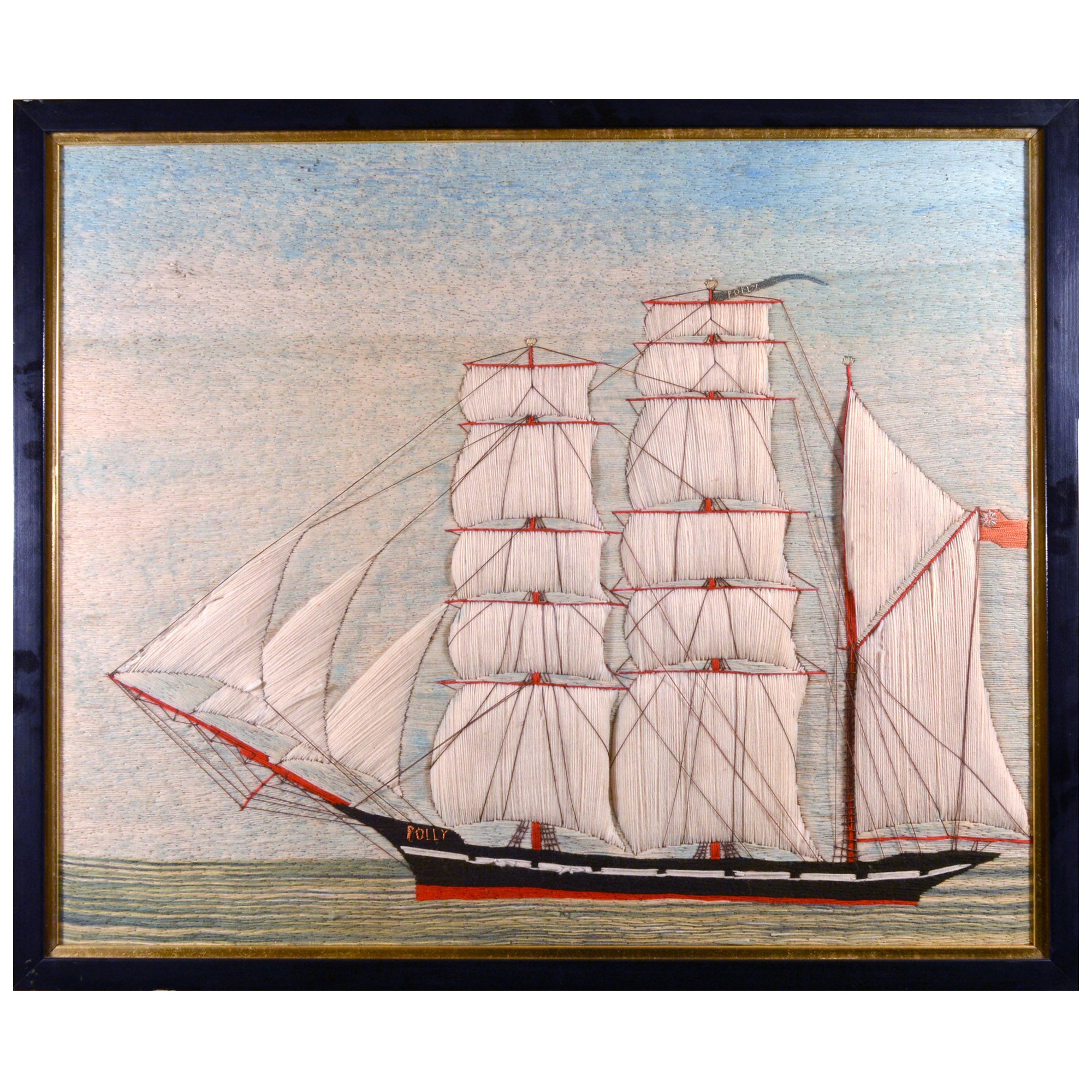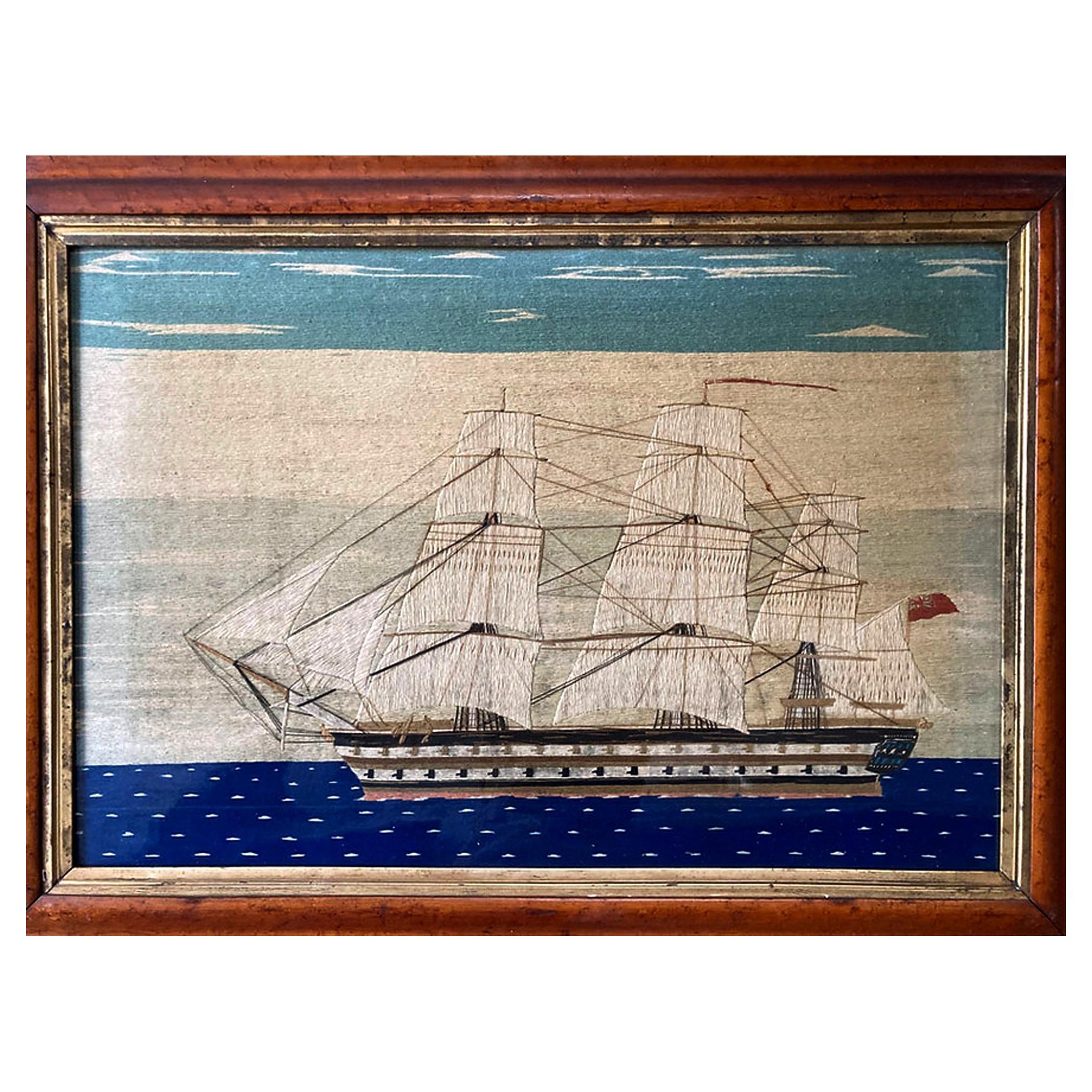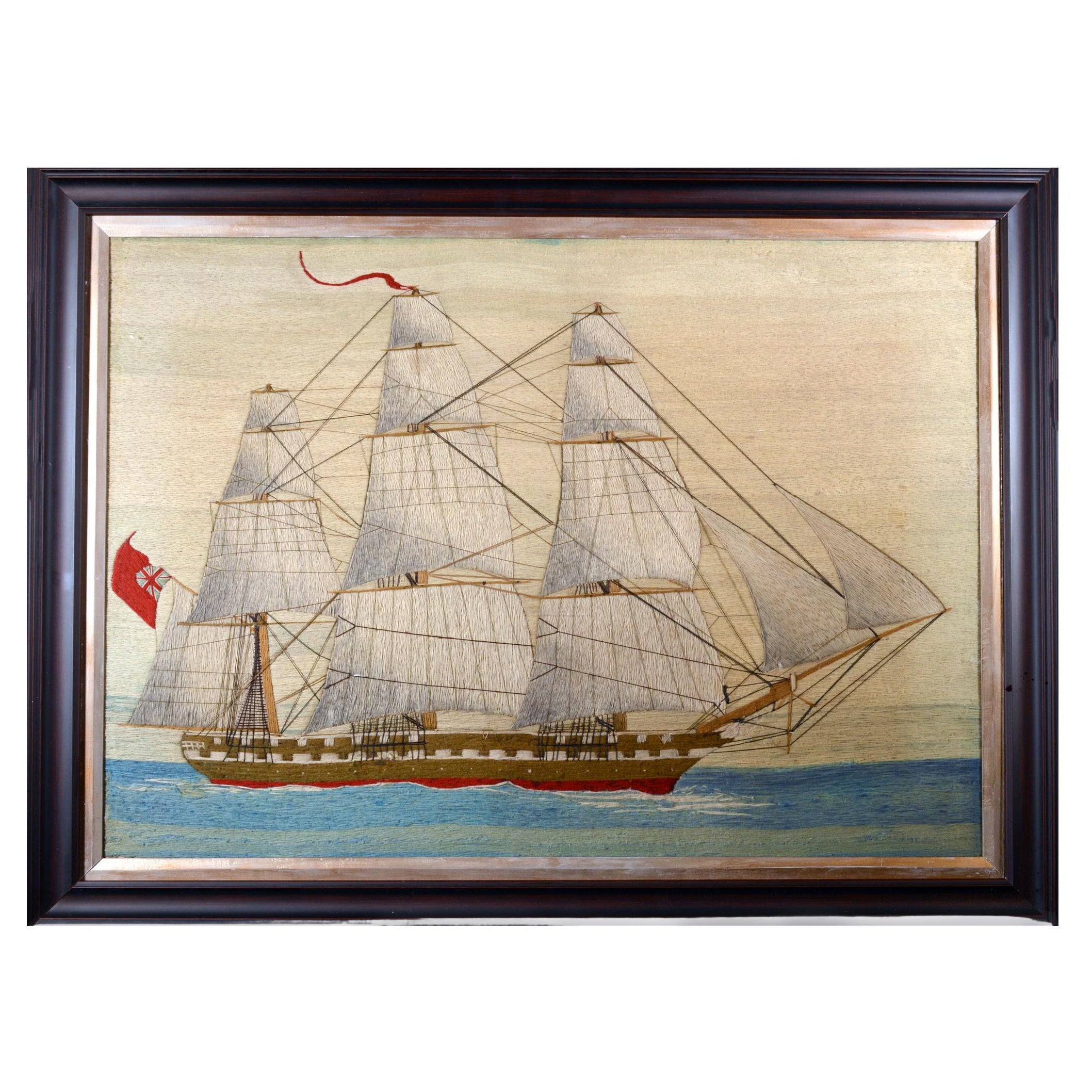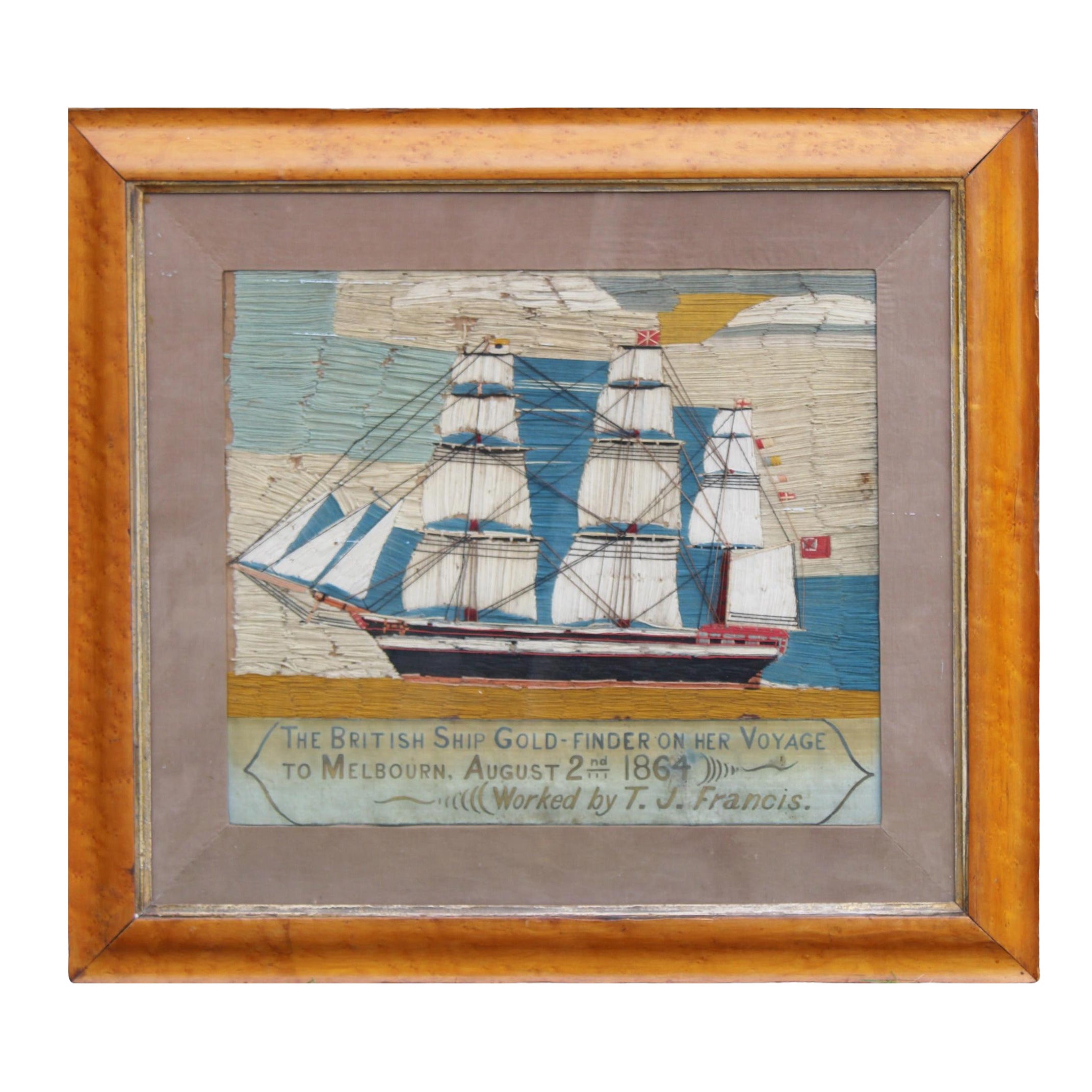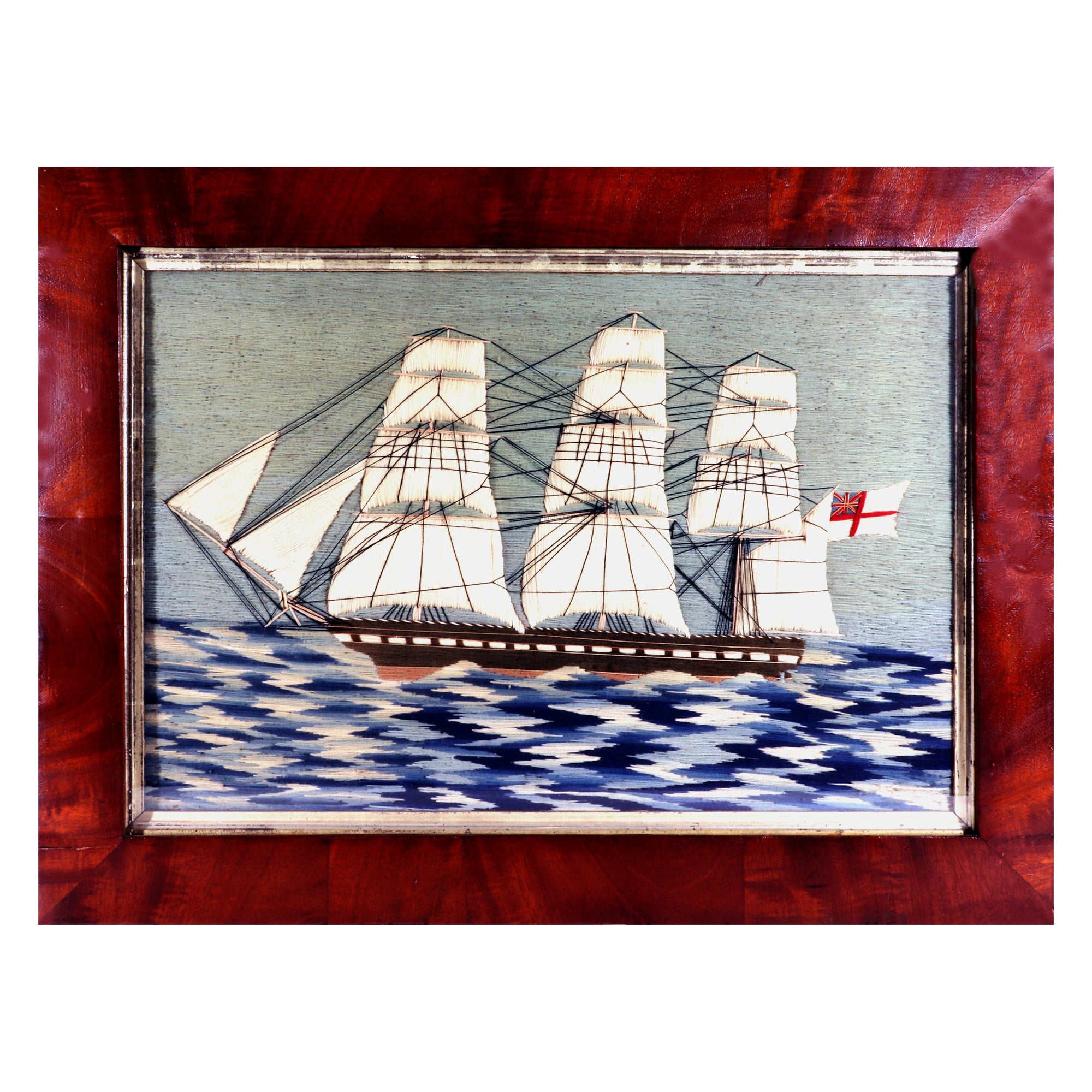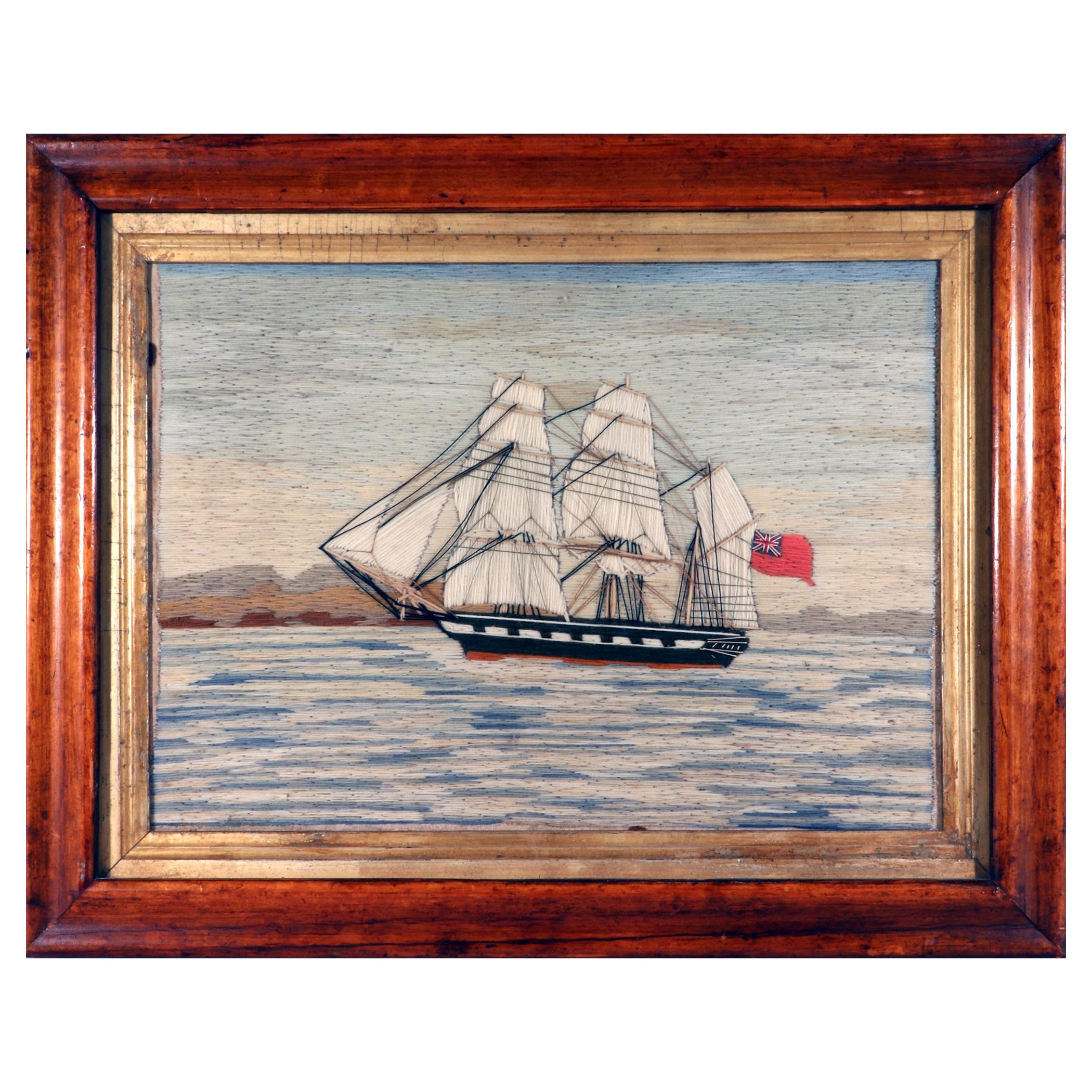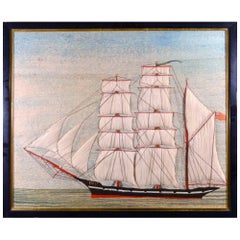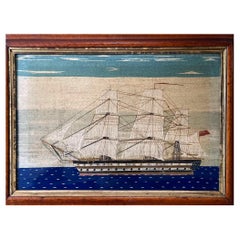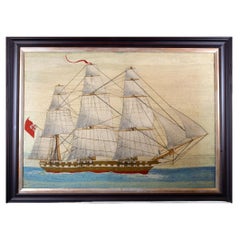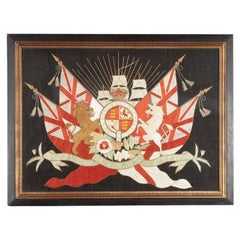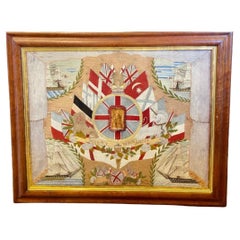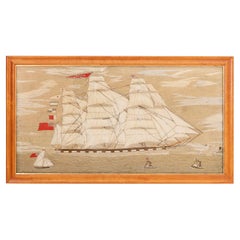Items Similar to British Sailor's Large Woolwork with Ship named The City of Rome on a Rough Sea
Want more images or videos?
Request additional images or videos from the seller
1 of 11
British Sailor's Large Woolwork with Ship named The City of Rome on a Rough Sea
About the Item
British Sailor's Large Woolwork with Ship named The City of Rome on a Rough Sea,
Nineteenth Century.
The large sailor's woolwork or woolie depicts a view of the ship, SS City of Rome, with three funnels and four masts. On the bow is stitched the ships name "CITY OF ROME". She flies a number of flags: the Red Ensign on the foremast, an anchor flag on the main mast, a red banner on the mizzenmast as well as an American flag on the jigger mast.
There are two smaller ships in the foreground, all on a choppy sea with multiple colors of blue and white. The wool is within a maple frame.
She is considered one of the most beautiful steamships built, with her classic clipper bow and sail rigging illustrating the transitional period of sail to steam
Frame: 26 1/4 inches high x 33 1/4 inches wide x 2 1/10 inches deep.
Now with Museum Conservation Glass.
Reference:
City of Rome was a British ocean liner, built by the Barrow Ship Building Company for the Inman Line to be the largest and fastest liner on the North Atlantic route. Though not achieving the requested specifications due to design compromise, and so returned to Barrow-in-Furness after only six voyages, she is considered one of the most beautiful steamships built, with her classic clipper bow and sail rigging illustrating the transitional period of sail to steam. The Anchor Line managed her on various routes until 1900. She was scrapped in 1902.
Development and design
The completion of the Guion Line's Arizona in 1879 forced all major trans-Atlantic companies to consider building new high-speed passenger liners. Designed by William John, who later would design the United States Navy's first battleship, the USS Texas, City of Rome was Inman's answer. She was a much larger ship designed to cross the Atlantic at 18 knots (33 km/h). City of Rome carried 520 first class passengers in quarters of especially high quality, as well as 810 in the inexpensive steerage class. She was one of the first liners to be lighted entirely by electricity.
Wikipedia
(Ref: NY10499-cmrr)
- Dimensions:Height: 26.25 in (66.68 cm)Width: 33.25 in (84.46 cm)Depth: 2.125 in (5.4 cm)
- Style:Folk Art (Of the Period)
- Materials and Techniques:
- Place of Origin:
- Period:
- Date of Manufacture:1880s
- Condition:Wear consistent with age and use. Museum Conservation Glass.
- Seller Location:Downingtown, PA
- Reference Number:Seller: NY10499-cmrr1stDibs: LU861040018292
About the Seller
5.0
Recognized Seller
These prestigious sellers are industry leaders and represent the highest echelon for item quality and design.
Gold Seller
Premium sellers maintaining a 4.3+ rating and 24-hour response times
Established in 1916
1stDibs seller since 2009
404 sales on 1stDibs
Typical response time: 1 hour
Associations
The Art and Antique Dealers League of AmericaAntiques Associations Members
- ShippingRetrieving quote...Shipping from: Downingtown, PA
- Return Policy
Authenticity Guarantee
In the unlikely event there’s an issue with an item’s authenticity, contact us within 1 year for a full refund. DetailsMoney-Back Guarantee
If your item is not as described, is damaged in transit, or does not arrive, contact us within 7 days for a full refund. Details24-Hour Cancellation
You have a 24-hour grace period in which to reconsider your purchase, with no questions asked.Vetted Professional Sellers
Our world-class sellers must adhere to strict standards for service and quality, maintaining the integrity of our listings.Price-Match Guarantee
If you find that a seller listed the same item for a lower price elsewhere, we’ll match it.Trusted Global Delivery
Our best-in-class carrier network provides specialized shipping options worldwide, including custom delivery.More From This Seller
View AllBritish Sailor's Woolwork or Woolie of the Named Barque "Polly"
Located in Downingtown, PA
Large British Sailor's Woolwork of the Barque Polly,
Named "Polly",
Circa 1885-95
A large sailor's woolie or woolwork of a port side view of a ship named "Polly" under full sail. The ship is rigged as a barque.
The name "Polly" can be seen on a banner flying from the mainmast and on the front of the bow and the shiop was named after the owner's wife Marian Poyy Woodside. (see below). The sails are trapunto, creating a three-dimensional look of the sails full of wind. The sea is depicted is rippling bands of green and white.
Dimensions: Frame: 26 1/4 inches high x 31 inches wide x 2 inches
Reference: The ship was built in Belfast, Northern Ireland, in 1885, and launched by Marian "Polly" Woodside, the wife of the owner, tossing flowers across the bow. (Champagne being too precious). The ship made several voyages primarily between South America and the UK before being repositioned in the Pacific.
A barque has three or four masts. The fore and mainmast are square-rigged, and the mizzen fore-and-aft, usually gaff-rigged. Carries a mainsail on each mast, but the mainsail shape differs per mast (square or gaff). Barques were built with up to five masts. Four-masted barques were quite common.
Barques were a good alternative to full-rigged ships because they require a lot fewer sailors. But they were also slower. Very popular rig for ocean crossings, so a great rig for merchants who travel long distances and don't want 30 - 50 sailors to run their ship.
A label on the reverse states that the wool was on The Antiques Road...
Category
Antique Late 19th Century English Folk Art Decorative Art
Materials
Wool
British Sailor's Large Woolwork of HMS Brunswick
Located in Downingtown, PA
British Sailor's large woolwork of HMS Brunswick,
Made by J. H. Miller, Brixton,
Circa 1865
The large-scale sailor's woolwork depicts an image of a Royal Navy Second Rate Battleship...
Category
Antique Mid-19th Century English Folk Art Decorative Art
Materials
Wool
British Sailor's Large Woolwork of a Royal Navy Ship Under Full Sail
Located in Downingtown, PA
British Sailor's large woolwork of a royal navy ship under full sail,
circa 1875
The sailor's woolie or woolwork depicts a starboard ...
Category
Antique Mid-19th Century English Folk Art Decorative Art
Materials
Wool
Sailor's Woolwork of The British Ship Gold Finder on her voyage to Australia
Located in Downingtown, PA
Sailor's Woolwork Nautical Picture,
Inscribed:The British Ship Gold Finder on her voyage to Melbourn, August 2, 1864. Worked by T.J. Francis,
Circa 1864
This sailor's woolwork depicts aportside view of the the Gold Finder. The Gold Finder was a 3-masted iron ship built in 1863 by J. Laing of Sunderland. There is a detailed inscription below including the maker's name- T.J. Francis.
A notice in the Liverpool Mercury on Tuesday May 3, 1853......This ship is expected to sail very fast, has all her passenger arrangements on a novel and peculiar plan, affording an amount of light and ventilation such as no other passenger ship ever possessed. The ships bell has recently been acquired by the Merseyside Maritime Museum. It seems though that the ship's description involved a degree of hyperbole as she was in fact laid down as a coal ship and converted to passenger accommodation later to meet the demand for the Gold Rush in Australia.
Dimensions: Framed: 28 3/10 inches high x 31 inches wide (72cm x 79 cm).
The Australian gold rush started after Edward Hargraves found the precious metal in New South Wales in 1851. He was not the first to discover gold but is credited with launching the stampede when thousands tried their luck at unearthing wealth - and some succeeded. Hargraves (1816-1891), a former hotelier and cattle farmer, played a small part in the California gold rush of 1849. He didn't get rich but met people who knew about gold and where it could be found - they pointed out similarities between California and New South Wales. Hargraves headed back to Australia to test these theories and stake a claim for a Government reward for the discovery of viable gold fields. Despite initial setbacks, he organised fellow prospectors in the quest for gold which was successful. Hargraves was granted massive rewards of more than pounds 12,000 and later a pension of pounds 250 a year.
He was born in Gosport, Hampshire, the son of an army officer, and educated at Lewes and Brighton Grammar School. Hargraves joined the merchant navy before arriving at Sydney in 1832 and marrying Eliza Mackie four years later.
Publicity about the gold rush prompted many migrants to sail from Liverpool to seek their fortunes - the first licence was issued in Victoria on 21 September 1851. Australia's population boomed as the emigrants...
Category
Antique Mid-19th Century English Folk Art Decorative Art
Materials
Wool
Sailor's Woolwork of Royal Navy on Checkerboard Sea
Located in Downingtown, PA
British Sailor's Woolwork of Royal Navy on Checkerboard Sea,
circa 1865
The British sailor's woolie depicts a port side view of a three-masted ship with trapunto white sails on a rough sea depicted as a checkerboard in shades of blue. The ship flying the White Ensign. The sky still retains the original light blue. The woolie is in a wide medium dark wood frame.
The wool is protected by Museum UV...
Category
Antique Mid-19th Century English Folk Art Decorative Art
Materials
Wool
British Sailor's Woolwork of a Royal Navy Ship with Red Ensign
Located in Downingtown, PA
British Sailor's Woolwork of a Royal Navy Ship
circa 1765
The sailor's woolwork, also known as a woolie, depicts a port side view of a ...
Category
Antique Mid-19th Century English Victorian Decorative Art
Materials
Wool
You May Also Like
19th Century Sailor's Woolwork Royal Coat of Arms
Located in Tetbury, Gloucestershire
Charming and characterful 19th Century British sailor’s woolwork art picture and frame.
Depicting the British Royal Coat of Arms. Raised silkwork lion and unicorn supporters, flanking embroidered coat...
Category
Antique 19th Century English Decorative Art
Materials
Wool, Wood
British Sailor's Woolwork or Woolie Lighthouse Seascape C. 1865
Located in Atlanta, GA
Measures:
28.5" w x 24.5" h (frame),
19" w x 15" h (image).
This intricately crafted 19th-century sailor’s woolwork embroidery, often referred to as a woolie, depicts a serene mari...
Category
Antique Mid-19th Century British British Colonial Paintings
Materials
Wool, Birdseye Maple
Mid 19th Century Sailor's Elaborate Woolie
Located in Nantucket, MA
Antique Sailor's elaborate woolwork, circa 1855, with a photograph of the sailor held in a woolwork frame set on the British flag on a cruciform reserve; with the "Honi Soit Qui Mal ...
Category
Antique 1850s English Folk Art Nautical Objects
Materials
Wool
Wool Work 'Woolie' Needlepoint Embroidery of the British Ship Amelia
Located in Palm Beach, FL
Large antique needlepoint of the British sailing ship Amelia hand crafted in wool, popularly known as woolies, crafted with ambitious detail. Pres...
Category
Antique 19th Century English Victorian Decorative Art
Materials
Wool
Decorative Oil on Canvas Painting of the City of Marbella
Located in Marbella, ES
Decorative Oil on Canvas Painting of the City of Marbella
Measurements with frame: 56x73x3cm
Category
Vintage 1970s Spanish Paintings
Materials
Canvas, Wood
Sinbad with the Old Man of the Sea on His Back Original Oil Painting
Located in San Francisco, CA
Sinbad with the old man of the sea on his back original illustration oil painting, 19th century.
A fine oil illustration from the Tales of the Ar...
Category
Antique Late 19th Century English Paintings
Materials
Canvas
